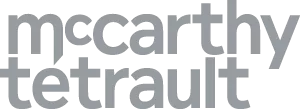On February 26, 2025, McCarthy Tétrault invited clients and colleagues into our offices and online across Canada for our 15th annual Retail and Consumer Markets Summit. The summit spanned a diverse array of topics and legal updates affecting the retail industry. Given ongoing political developments, the beginning of 2025 had been marked by uncertainty, and our speakers shared valuable insights about the key legal considerations that should be top of mind in navigating times like these.
Takeaway 1: Collaboration with retail associations is key to face disparate and evolving standards and regulations throughout the US.
Our keynote speaker, Deborah White (Retail Industry Leaders Association), noted that DEI and ESG programs and initiatives have faced scrutiny from the new US administration. Retailers and manufacturers are trying to comply with ever changing policies, while also honouring the core values that are vital to attracting consumer interest and a strong employee workforce.
Fostering knowledge-sharing and collaboration is key to enduring uncertain market conditions and geopolitical risk in supply chain planning and strategic decision-making. Deborah suggested that trade associations can be one way to engage in knowledge-sharing and collaboration with peers and experts. For example, the Retail Industry Leaders Association can be a helpful source of information about what's happening in the United States in terms of market integration for retailers and manufacturers engaged in cross-border activity. The Retail Counsel of Canada would also be a good organization to consult.
Takeaway 2: Protectionist policies in the US are a major preoccupation for Canadian businesses.
The recent surge of trade and tariff announcements has significantly impacted Canadian businesses, who are struggling stay on top of what appear to be constantly changing tariff applications, and related contradictory updates. The United States' aggressive use of trade measures is unprecedented in recent history, as it relates to US/Canada relations.
President Trump favours the application of tariffs, even as against the United States' closest ally, as a means to address several key policy and economic preoccupation:
- "America First" Policy: The Trump administration continues to focus on this broad political and economic doctrine, which emphasizes U.S. interests above international interests. It impacts several areas of government policy, including trade, immigration, foreign relations, and domestic economic policies. Among the key objectives is President Trump's desire to repatriate manufacturing into the United States.
- "Unfair" Trade Practices: Using trade policy to try to push back against what the current U.S. administration considers to be unfair trade practice, such as measures akin to dumping and subsidy issues, manipulating currency to increase exports, and other similar measures.
- Trade Deficit: Donald Trump's position is that a country in a trade deficit is not demonstrating an economy as strong as it would be if it were in a trade surplus. The United States currently has trade deficit with Canada, meaning it imports more from Canada than Canada imports from the US. Notwithstanding all of the reasons that explain the trade imbalance, such as massive population disparity and U.S. reliance on Canadian energy products, President Trump maintains that the trade deficit is proof positive that Canada and other trading partners have taken advantage of the United States for years.
- National Security: In order to pursue tariff application through Executive Orders, President Trump is relying on rarely-used statutory authorities that apply in times of emergency. More specifically, the U.S. administration is taking the position that overreliance on imports of foreign goods constitutes a national emergency, to be addressed and solved through increased domestic production. However, Martha notes that internationalism in the retail sector is absolutely essential for retailers (especially cross-border retailers) to be successful at domestic or global level and that the expectation that retailers will move away from global supply chains and focus on domestic supply chains is not realistic.
For more details on the imposed tariffs, see our most recent blogs on this subject:
- Trade War Underway: Trump Tariffs Unpaused and Canada's Retaliatory Measures
- Canada Responds to U.S. Tariffs – What Businesses Need to Know
Takeaway 3: Tariff uncertainty is having repercussions on supply chain planning.
The threat of impending tariffs, further exacerbated by the possibility of reciprocal tariffs, is having a chilling effect on supply chain planning which may lead Canadian retailers to increase their proportion of sales domestically, leading to a potential increase in domestic supply that is generally favorable to Canadian consumers.
Takeaway 4: Canadian businesses should be wary of "Maple Glazing" claims.
Canadian businesses are starting to take advantage of the cultural phenomenon of political patriotism that Canadian consumers are exhibiting in response to threats of tariffs on Canadian products, as well as reciprocal tariffs on American goods. In recent years, the Competition Bureau has turned its attention to misleading advertising; while this has recently been focused on greenwashing claims about environmental impacts, this scrutiny on misleading advertising will now also expand to include "Made in Canada" claims. McCarthy Tétrault's recently coined "Maple Glazing" (for more information, see our blog post on the topic), which is the analogue to greenwashing when it comes to making misleading representations about the Canadian origin or manufacturing of a product.
Of note, the Canada Border Services Agency and Canadian Food Inspection Agency are both also attentive to misleading "Made in Canada" claims, but retailers and manufacturers should be mindful of the fact that the applicable tests from a trade and food commodity perspective differ from the Competition Bureau's thresholds.
Takeaway 5: Businesses operating in Canada should expect more enforcement of greenwashing claims.
On December 23, 2024, the Competition Bureau provided proposed guidelines1 on the Competition Act's new greenwashing provisions, which came into force in June 2024. In these guidelines, the Competition Bureau specified that environmental claims relating to a business or business activities must be substantiated with reference to internationally recognized methodologies, which the Competition Bureau defines as a standard even used by only two countries (it does not necessarily need to be the strictest methodology available). The Competition Bureau also clarified that the statements captured by the Competition Act are those made for promotional reasons, which would exclude (for example) statements made in securities filings.
As of June 20, 2025, the new provisions notably allow for a private right of action whereby an applicant may obtain leave from the Competition Tribunal to bring a deceptive environmental marketing claim against a business. Retailers and manufacturers should expect further scrutiny of environmental claims both by the Competition Bureau in 2025.
Takeaway 6: Uncertainty in the market is having repercussions on M&A activity.
In January 2025, we unfortunately witnessed the lowest level of M&A deal activity in the past decade. Confronted by the implications of potential tariffs and protectionist economics, market stakeholders have been adopting a wait-and-see approach. Their concerns are compounded by a tightening of the labour force and the highest levels of inflation in the United States since 2023. In terms of activity, consolidation has continued to be trending, including many deals in the making in the grocery and the luxury spaces.
Takeaway 7: Joint Ventures as a less-risky endeavour.
In a time of increased market risk, joint ventures, whether traditional or synthetic (i.e. licensing and distribution deals) can be an alternative to traditional M&A. These are interesting solutions which allow retailers and manufacturers to expand market presence without incurring the costs and risks of a full-scale acquisitions. It can also allow for mutually beneficial areas of collaboration and growth with market participants who may already have a deep knowledge of the consumer space for example. Legal counsel can play a meaningful role in such partnerships through diligence and careful contract drafting. A nuanced and well-thought-out contract can mitigate risk in the governance of the joint venture and foresee potential exit strategies, if needed.
Takeaway 8: The intersection of copyright law and rising prevalence of AI models is a hot button issue for market participants and regulators alike.
Copyright infringement claims in connection with AI-generated content for product design and advertising campaigns is increasingly being brought before courts worldwide. Further, there is a slew of litigation regarding the data sources used to train AI models alleging that copyrighted material was wrongly utilized in the training process. Recently, in Thomson Reuters v. Ross2, the Court found that the fair use (or fair dealing) defense did not apply to the use of case law headnotes drafted by Thomson Reuters and available on the Westlaw platform.
Retailers should strategically balance their use of AI with human input to mitigate the risk of losing copyright protection of key advertising campaigns or intellectual property. Barry Sookman (McCarthy Tétrault) suggests that both AI input and output must be subjected to careful human oversight and review prior to use.
The Competition Bureau has also urged market participants to proceed with caution when using AI models to create pricing schedules factoring in the pricing of competitors, as this may have anti-competitive consequences.
Takeaway 9: New privacy law focuses are emerging in 2025.
Privacy law reform will continue as it has: through the courts and privacy commissioners. While the federal government's recent attempt at reform died when parliament was prorogued, it was clearly not a priority in any event. If there is to be any reform, it will likely be motivated by trade concerns--that could mean harmonizing Canada's federal and provincial privacy laws internally or aligning with a major trading partner. For 2025, the evolution of privacy law will be driven by Canada's privacy regulators and by the courts.
Privacy regulators at both the federal and provincial levels will be focusing on:
- emerging technology, such as smart devices and artificial intelligence; and
- children's privacy rights (for example, protection of children's privacy was a key topic in the Office of the Privacy Commissioner of Canada's 2024 Sweep Report on Deceptive Design Patterns and is one of top three priorities for their 2024 - 2027 Strategic Plan).
Retail will always be an area of focus for privacy regulators. The need for compliance efforts is heightened when using new technologies or when engaging the privacy rights of minors.
Takeaway 10: Canadian courts have provided recent guidance on the legal responsibility of retailers and manufacturers for dangerous and/or defective products.
In a rapid-fire review of recent Canadian cases, the following stands out:
- a distributor can be held to the same standard of responsibility as a manufacturer for a defective product in the case of recalls3;
- when a specific risk is known to a manufacturer, labelling should reflect that specific risk (for example, a general warning to keep a container closed and in a well-ventilated space is not sufficient if there is a known risk of metal corrosion)4; and
- worries of future harm based on weak science unlikely to provide sufficient foundation for claims for product claims5.
For more on this subject, see our latest Key Product Liability Update.
Takeaway 11: As mass arbitration rises in the US, retailers and manufacturers should review their terms and conditions to ensure compliance with laws in Canada.
In Canada, most applicable provincial legislation does not allow parties to an agreement to contract out of class actions. Clauses regarding arbitration should be carefully reviewed for compliance with both US and Canadian markets.
Takeaway 12: Class actions are increasingly sophisticated, especially in employment law contexts.
Employment-related class actions are on the rise in recent years, even leading to the emergence of law firms specializing in this type of action. As a direct consequence, class actions are becoming increasingly sophisticated in centering around common employer policies, procedures and practices. The main battleground of these claims predictably continues to be certification of the class action.
Takeaway 13: Restrictive covenants, exclusivity clauses and property controls are under increasing levels of scrutiny in real property leasing.
Restrictive covenants are commonly included in leases and property deeds. When negotiating these clauses, it is important to capture subsequent owners or tenants in the language creating the restriction, as these restrictions are often classified as personal rights, as opposed to real rights. Limitations which focus on commercial activities rather than the immovable itself (e.g., building height) run the risk of being interpreted as non-competition clauses and thus not being considered real rights opposable to third parties.
Recent amendments to the Competition Act allow the Competition Bureau to scrutinize these property controls and limitations under abuse of dominance provisions, for example, even in cases where the parties are not direct competitors. Certain retailers, including grocers, have recently slowed and in some instances stopped their use of property controls.
Takeaway 14: Tax treatment of loyalty points was recently reviewed by the Tax Court of Canada and remains a topic of interest.
The GST/HST treatment of loyalty points was revised in the The Toronto-Dominion Bank v. The King6 decision by the Tax Court of Canada. In this case, TD Bank argued that the sale of loyalty points should be considered gift certificates, which mean that no sales tax should have applied at the time of sale, and GST/HST obligations would apply only when the sold points were redeemed. This argument was, however, rejected by the Tax Court of Canada, on the basis that the loyalty points at issue did not have the characteristics of a gift certificate noting in particular that the points did not have a stated monetary value, were not transferable without paying a significant fee to the issuer and necessitated the accumulation of more loyalty points as condition to redeeming a single "unit" of benefit (a single Aeroplan Mile, in this case). TD Bank has appealed the decision to the Federal Court of Appeal but the appeal has not yet been heard.
To read more on this decision, please consult our previous blog on this topic.
Takeaway 15: There is a rise in class actions aimed at recovering GST/HST amounts incorrectly paid by consumers.
Consumer class action claims are being structured to claim damages equivalent to the GST/HST amounts paid alleging that suppliers made false or misleading representations.
This result runs contrary to the Excise Tax Act ("ETA") which is a complete statutory framework that provides mechanisms for consumers to recover the GST/HST wrongly paid to or collected in error by the supplier. Specific provisions in the ETA prohibit lawsuits and class actions against the supplier for the recovery of sales tax collected and remitted by the supplier, as was in fact recently confirmed by the Ontario Court of Appeal in Lewis v. Uber7, a case that was successfully argued by McCarthy's litigation group.
Footnotes
1. Government of Canada, "Environmental claims and the Competition Act", (December 23, 2024), available online: https://competition-bureau.canada.ca/en/how-we-foster-competition/consultations/environmental-claims-and-competition-act.
2. Thomson Reuters Enterprise Centre GmbH v. Ross Intelligence Inc., No. 1:20-cv-613-SB (D. Del. Feb. 11, 2025).
3. Muss v. 735084 Alberta Inc., 2024 BCSC 2078.
4. Reckitt Benckiser (Canada) inc. c. Société d'assurance Beneva inc. (La Capitale Assurances Générales Inc.), 2024 QCCA 958.
5. Palmer v. Teva Canada Ltd., 2024 ONCA 220.
6. The Toronto-Dominion Bank v. The King, 2024 TCC 50.
7. Lewis v. Uber, 2023 ONSC 6180.
To view the original article click here
The content of this article is intended to provide a general guide to the subject matter. Specialist advice should be sought about your specific circumstances.



















